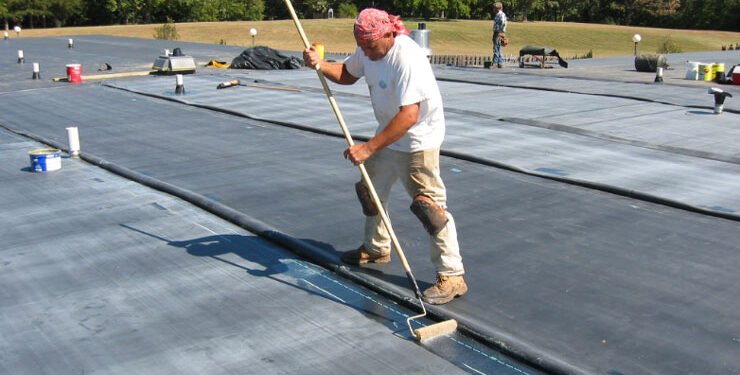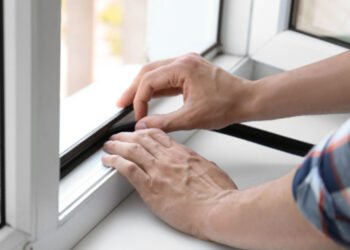Whether you’re a contractor, architect, or specifier, understanding the correct methods and materials for penetration detailing is essential. This comprehensive guide walks you through every aspect of detailing single ply roofs around penetrations, from preparation to testing.
What Are the Common Types of Roof Penetrations Encountered in Single Ply Systems?
Single ply roofing systems frequently encounter a variety of roof penetrations, each requiring specialized detailing to ensure a watertight seal. These penetrations often serve mechanical, electrical, or structural functions and must be addressed carefully during membrane installation.
Typical Roof Penetrations Include:
- Vent pipes – plumbing or heating system outlets
- HVAC ducts – supply and return ventilation paths
- Electrical conduits – cable trays, lightning protection systems
- Roof drains and outlets – flat roof drainage systems
- Support posts and stanchions – for plant equipment or solar panels
- Skylights and rooflights – daylight entry points
Penetration Shapes:
- Circular (e.g. pipes, conduits)
- Rectangular (e.g. ductwork)
- Irregular/custom (e.g. grouped services or angled posts)
Why Is Correct Detailing Around Penetrations Critical to Waterproofing Integrity?
In any single ply membrane roof system, penetrations like pipes, vents, drains, and supports are the most vulnerable points for water ingress. Proper detailing in these areas is critical to:
- Prevents Leaks
Poorly sealed penetrations create entry points for water, leading to leaks and potential internal damage.
- Maintain Membrane Continuity
Proper detailing ensures the membrane remains watertight even around irregular shapes or objects.
- Avoid Structural Damage
Water infiltration through penetrations can compromise insulation, decking, and building interiors over time.
- Reduce Risk of Mold and Rot
Moisture trapped around poorly sealed penetrations encourages mold growth and timber decay.
- Ensures Compliance with Standards
Correct detailing meets industry standards and warranties, reducing liability and repair costs.
- Improves System Longevity
Durable, well-detailed seals around penetrations help extend the life of the entire waterproofing system.
Attention to detail around penetrations is not optional—it’s a critical factor in ensuring long-term waterproof performance and protecting the integrity of the entire structure.
What Materials and Accessories Are Typically Used for Penetration Detailing?
A range of specialized materials and accessories are used to ensure secure, watertight detailing around penetrations in membrane systems, as outlined below:
Essential Materials & Accessories
| Material/Accessory | Purpose / Application |
| Pre-Formed Pipe Boots | Seals round penetrations like pipes and vents quickly and securely. |
| Unreinforced Membrane Strips | Used for wrapping irregular shapes due to high flexibility and stretchability. |
| Compatible Sealant | Enhances watertightness at joints and accommodates movement or vibration. |
| Pressure-Sensitive Tapes/Flashings | Self-adhering materials ideal for quick sealing of overlaps and small details. |
| Termination Bars and Clamps | Mechanically secure membrane edges around vertical penetrations to prevent uplift. |
| Primer | Prepares surfaces to improve adhesion of tapes and flashings. |
| Protection Sleeves/Collars | Shields membrane around penetrations from damage and mechanical stress. |
Ensure all accessories are manufacturer-approved for compatibility with the single ply membrane in use (e.g. TPO, PVC, EPDM).
How Do You Prepare the Membrane and Substrate Before Detailing Begins?
Proper preparation of both the membrane and substrate is essential to ensure strong adhesion, effective waterproofing, and long-term performance of detailing around penetrations and terminations.
- Clean the Substrate
Remove dust, dirt, grease, moisture, and debris to create a clean bonding surface.
- Dry the Surface Thoroughly
Ensure the area is completely dry before applying primers, adhesives, or membrane components to prevent bond failure.
- Check for Surface Defects
Inspect for cracks, sharp edges, or irregularities that could damage the membrane or prevent full adhesion.
- Prime the Area
Apply a compatible primer (if required), especially when using pressure-sensitive tapes or adhesives, to enhance bonding strength.
- Cut and Prepare Membrane Sections
Pre-cut membrane pieces or accessories to the correct size and shape for easier and more precise installation.
- Ensure Temperature Compatibility
Make sure materials and surfaces are within the manufacturer’s recommended temperature range for proper bonding.
Prepare necessary unreinforced patches, collars, or field-fabricated shapes to streamline the process.
What Are the Step-by-Step Procedures for Detailing Around Circular and Rectangular Penetrations?
Detailing around penetrations is a critical task in waterproofing to ensure long-term integrity of the membrane system. Below are step-by-step procedures for both circular and rectangular penetrations.
Detailing Around Circular Penetrations
- Install Pipe Sleeve (optional)
Place a protective sleeve if the pipe material is incompatible or subject to heat.
- Apply Base Flashing Patch
Cut a circular or square base patch, slit it to fit snugly around the pipe, and adhere using bonding adhesive.
- Form Collar or Boot
Use a pre-formed boot or wrap unreinforced membrane around the pipe, overlapping the base patch.
- Seal Vertical Overlap
Use membrane sealant or hot-air weld the seam depending on membrane type.
- Add Clamping Ring
Secure top edge of collar with mechanical clamp and sealant bead for added waterproofing.
Detailing Around Rectangular Penetrations
- Base Flashing
Install L-shaped membrane patches on each face of the penetration. - Corner Patches
Use pre-formed corners or custom-cut membrane to seal vertical corners.
- Vertical Flashing
Wrap a continuous strip around the vertical surface, overlapping corners and base.
- Weld or Seal All Seams
Ensure full continuity of seams with no gaps or fish-mouths.
Following a careful, step-by-step approach tailored to each penetration type ensures long-lasting, watertight seals that maintain the integrity of the entire membrane system.
How Should Corner and Edge Conditions Be Handled to Ensure a Watertight Seal?
Corners and edges are high-risk areas for water infiltration in membrane systems. Proper detailing and installation techniques are essential to create a continuous, watertight seal in these locations.
1. Internal Corners
- Use “butterfly” patches for a folded seam overlap.
- Weld seams outward to avoid water tracking inward.
2. External Corners
- Pre-formed corners are ideal for consistent, durable seals.
- Ensure overlap is sufficient per manufacturer guidelines (typically 50–75 mm).
3. Edges Around Grouped Penetrations
- Create a curb or boxed enclosure to simplify detailing.
- Minimise sharp angles to reduce membrane stress.
Properly executed corner and edge detailing is crucial for maintaining the waterproof integrity of the membrane, especially in areas most vulnerable to leaks and weather exposure.
What Are the Best Practices for Sealing Mechanical and Electrical Service Entries?
Sealing mechanical and electrical service entries—such as conduit pipes, cables, and HVAC penetrations—is vital for maintaining the waterproofing integrity of the membrane system. These entries are frequent sources of leaks if not properly detailed.
- Plan Penetration Locations Early
- Coordinate with trades to group entries where possible and avoid last-minute, unplanned penetrations.
- Coordinate with trades to group entries where possible and avoid last-minute, unplanned penetrations.
- Use Compatible Pipe Boots or Flashings
- Install pre-formed or custom-made boots specifically designed for the type and size of service penetration.
- Install pre-formed or custom-made boots specifically designed for the type and size of service penetration.
- Ensure Clean, Dry Surfaces
- Clean both the penetration surface and the surrounding membrane area to ensure optimal bonding.
- Clean both the penetration surface and the surrounding membrane area to ensure optimal bonding.
- Apply Primer if Required
- Use a compatible primer if working with pressure-sensitive tapes or adhesive-backed components.
- Use a compatible primer if working with pressure-sensitive tapes or adhesive-backed components.
- Secure Base with Adhesive or Hot-Air Weld
- Seal the flashing or boot base to the membrane using the manufacturer’s recommended method (adhesive or weld).
- Seal the flashing or boot base to the membrane using the manufacturer’s recommended method (adhesive or weld).
- Seal Around Entry Point
- Use flexible, UV- and weather-resistant sealant at the top edge or where cables/pipes emerge from the boot.
- Use flexible, UV- and weather-resistant sealant at the top edge or where cables/pipes emerge from the boot.
- Use Termination Clamps or Collars
- Mechanically secure boots around rigid services with stainless steel clamps to resist movement and uplift.
- Mechanically secure boots around rigid services with stainless steel clamps to resist movement and uplift.
- Reinforce Multiple or Tight-Grouped Entries
- Add extra flashing or membrane overlays where multiple entries are clustered closely together.
- Add extra flashing or membrane overlays where multiple entries are clustered closely together.
- Test and Inspect Seals
- Perform visual checks or water testing to confirm complete sealing before covering or continuing work.
How Can Pre-Formed Boots and Collars Improve Detailing Efficiency and Reliability?
Pre-formed boots and collars are factory-molded components designed specifically to seal around penetrations such as pipes, conduits, and posts in membrane systems. Their use significantly enhances both the efficiency and reliability of waterproofing detailing.
| Benefit | Explanation |
| Time Saving | Pre-moulded components reduce field fabrication |
| Consistency | Factory quality reduces on-site variability |
| Reliability | Better fit and fewer seams |
| Compatibility | Designed specifically for each membrane system |
Ideal Use Case:
- Circular pipe penetrations
- Pipes with frequent temperature changes
- Sites with time constraints or minimal skilled labour
Manufacturers like Sika, Carlisle, and Firestone offer a wide range of boots, collars, and prefabricated corners tailored to their membrane systems.
What Inspection and Testing Methods Verify the Integrity of Penetration Detailing?
Verifying the integrity of penetration detailing is essential to ensure a watertight roofing or waterproofing system. The following methods are commonly used during and after installation:
Visual Inspection:
- Check for wrinkles, fish-mouths, or incomplete welds
- Ensure all overlaps meet minimum specified dimensions
Probe Test:
- Use a seam probe to check mechanical strength of welds
Water Testing:
- Flood test or spray test the area for 24–48 hours
- Monitor for signs of leakage at the interior ceiling
Infrared or Moisture Scanning:
- Use thermal imaging to identify potential moisture beneath the membrane
| Inspection Type | When to Perform |
| Visual check | Immediately post-installation |
| Probe test | After welding |
| Flood test | Before insulation cover-up |
| IR scan | As part of ongoing maintenance |
These inspection and testing methods help verify that penetration detailing is properly sealed, preventing future leaks and ensuring long-term system performance.
Final Thoughts
Detailing single ply roofs around penetrations is one of the most critical tasks for ensuring long-term waterproofing performance. These areas are inherently weak points in the membrane system, but with the right materials, preparation, and attention to detail, they can be reliably sealed.
Whether you’re installing EPDM, TPO, or PVC, always follow manufacturer guidelines, use pre-formed accessories where appropriate, and conduct thorough inspections. By investing in quality detailing, you protect the roof system’s integrity, extend its lifespan, and avoid costly repairs or failures in the future.












